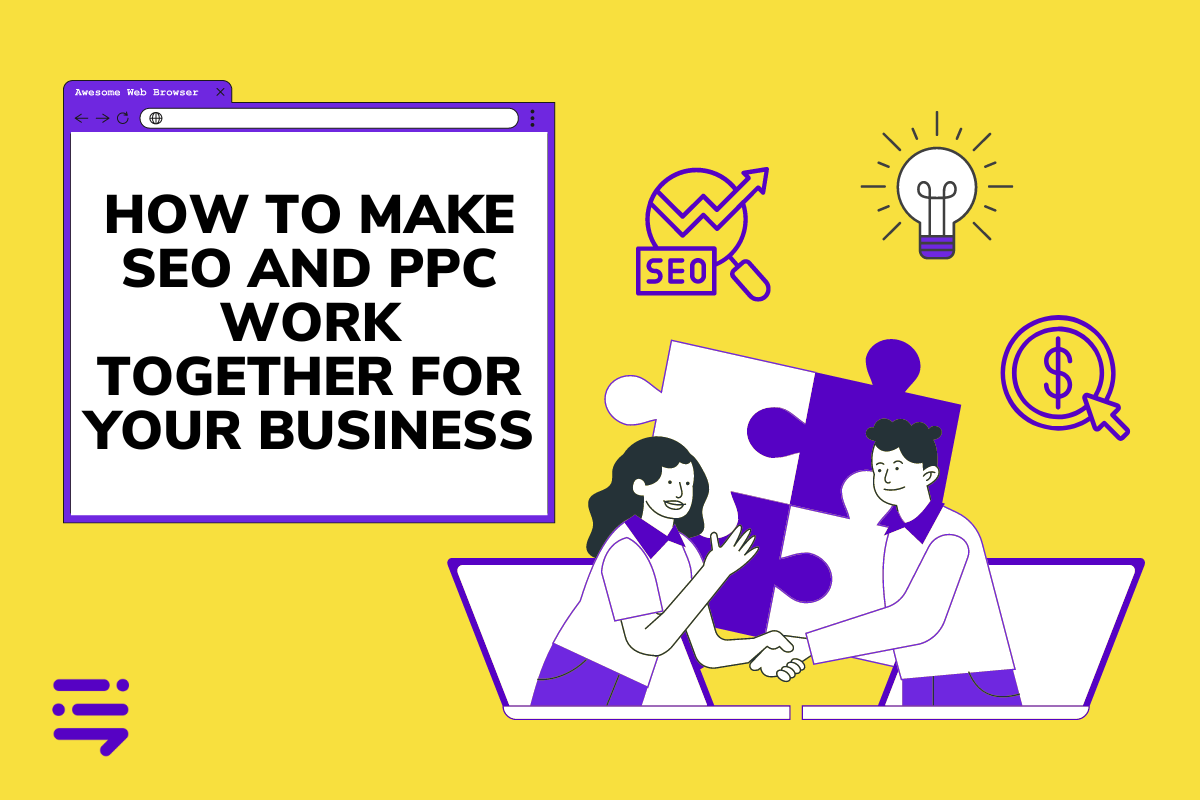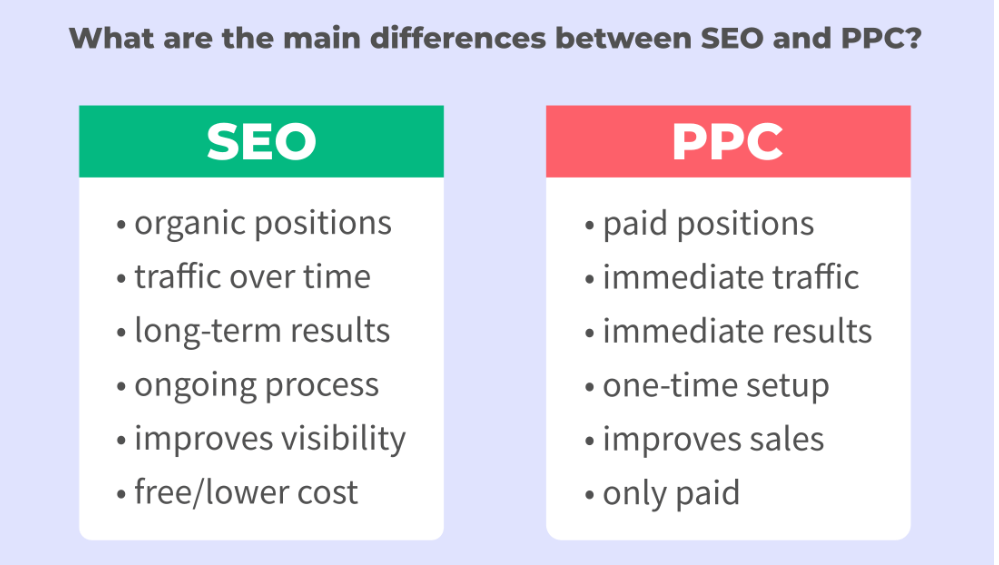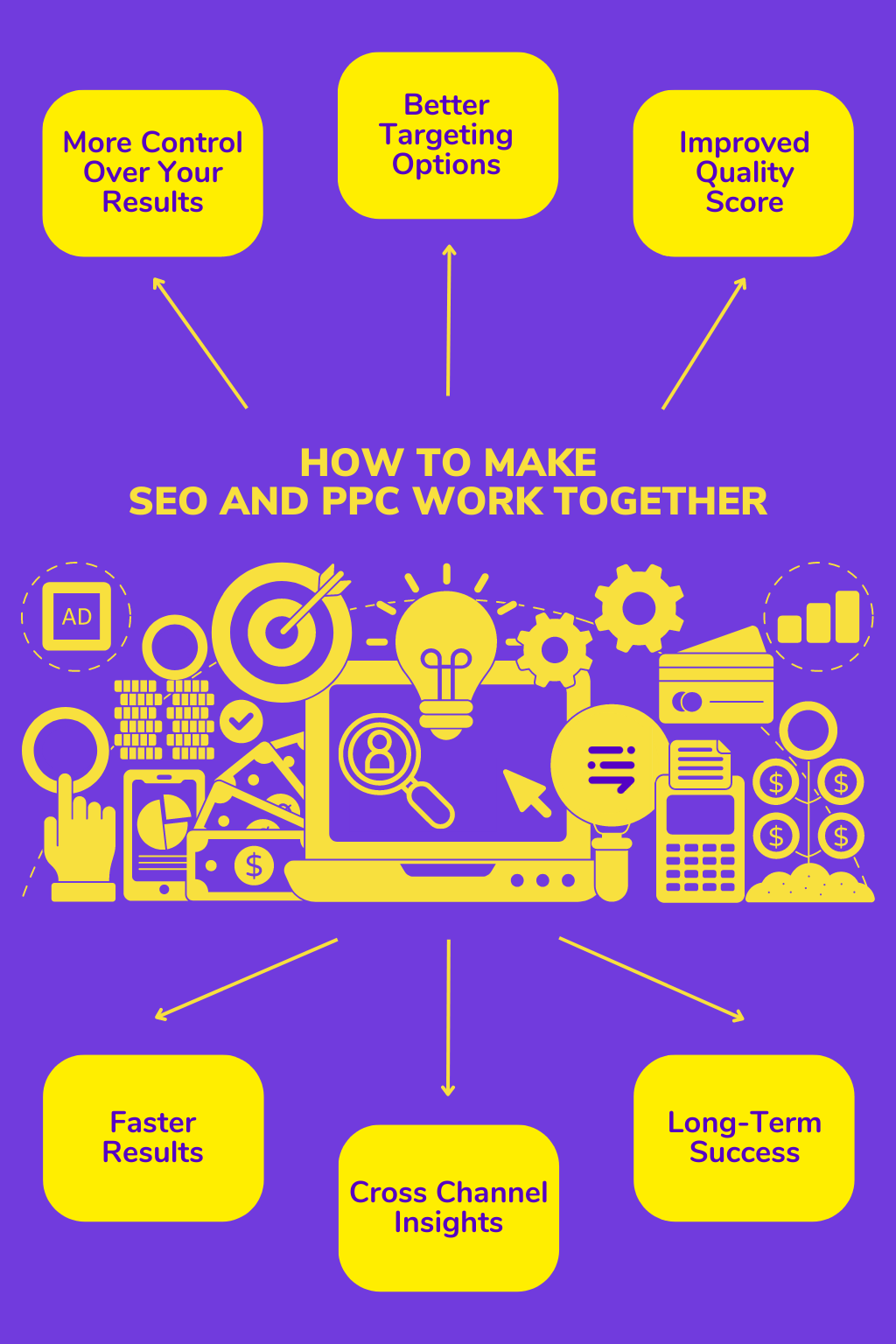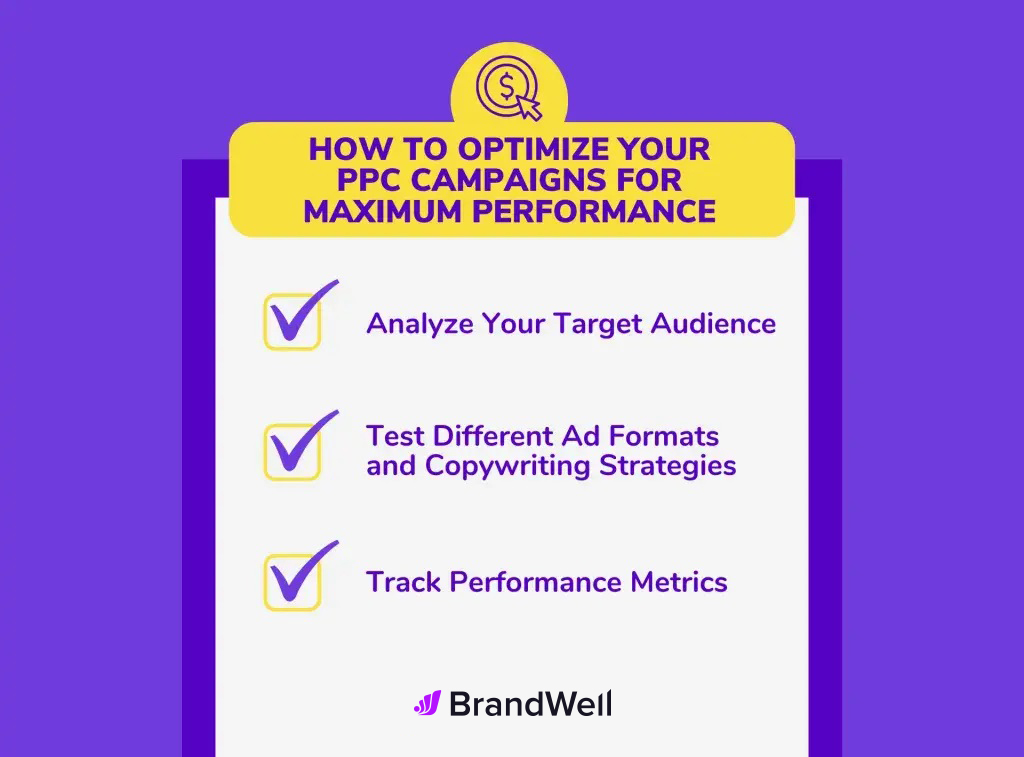Discover top guides, trends, tips and expertise from AIO Writers
How to Make SEO and PPC Work Together for Your Business
Farnaz Kia
Wednesday, 6th Dec 2023
SEO and PPC are two of the most important components of digital marketing. Both strategies can be extremely effective but can they co-exist? How to make SEO and PPC work together to achieve maximum results?
More than 86% of top marketers say they use PPC campaigns to inform their SEO efforts. Because PPC produces quick results, marketers can see what keywords resonate with their target audiences, and in turn, use these keywords to write new content for SEO. Instead of choosing between SEO and PPC, they turn their PPC campaigns into learning opportunities for SEO campaigns.
The key to developing an effective digital marketing strategy is to understand how PPC ads affect your SEO efforts and vice versa. Let’s explore why combining these two tactics is beneficial for your business and how to make SEO and PPC work together to implement a winning marketing strategy.
Table of Contents
SEO and PPC: Why They Are Similar
What is SEO? Search Engine Optimization is the process of optimizing a website to improve its visibility and rankings in organic (unpaid) search engine results.
What is PPC? Pay-per-click is a digital advertising model where advertisers pay a fee each time their ad is clicked, typically used to buy visits to their website rather than earning them organically.
SEO and PPC share some obvious commonalities. Both tactics aim to draw potential customers to a website.
Both are keyword-driven — advertisers conduct keyword research to identify profitable phrases while SEO marketers analyze relevant terms for optimization purposes.
Keyword Research Benefits Both Strategies
Keyword research is an important part of any search engine marketing strategy, whether it’s PPC or SEO.
Advertisers bid on keywords to reach their target audience while an SEO strategy will find keywords to optimize a website to get it to rank higher in organic search results.
By researching relevant terms that people are searching for online, marketers can better understand what topics resonate with users and create more effective campaigns that yield better results.
Leveraging Data from One Strategy to Another
Data gathered from one strategy can be used by the other, which helps maximize ROI across both channels.
For example, if you find certain keywords performing exceptionally well on your PPC campaigns, those same terms can be incorporated into your organic content efforts so you can reap similar rewards.
Similarly, data collected from organic searches such as average session duration or bounce rate can help inform how you structure future PPC campaigns so they’re more successful too.
SEO and PPC: Why They Are Different
SEO and PPC strategies may have the same goal — to drive traffic to a website — but that’s where their similarities end.
How are they different?
Visibility
Organic search results generated from SEO appear under paid ads on search engine listings, while PPC adverts usually appear at the top of these listings. This means that organic rankings must earn visibility through the successful implementation of SEO techniques such as content creation and link building, whereas advertisers who generate traffic from their ads will have to pay for those site visits.
Return on Investment
The return on investment with PPC keywords tends to be immediate – once an ad is clicked it will start generating awareness or conversions right away – but this effect may not last long after the promotion ends.
On the other hand, SEO strategies often take longer to gain momentum but can produce more sustainable results if implemented correctly. Once a company’s search optimization strategy begins producing results, those changes tend to remain in place for much longer than any short-term gains made through PPC campaigns.
Cost
When it comes to cost-effectiveness, both methods require an initial outlay of money before they begin producing returns.
With SEO, you only need to invest in quality content creation and technical optimization services. With PPC, you must also factor in ongoing costs every time someone clicks on your ad as well as additional fees charged by Google Ads or Bing Ads for hosting your campaigns.
With BrandWell, you don’t have to hire an army of writers to create content for both your SEO and PPC campaigns. BrandWell is a powerful all-in-one brand growth platform that’s trained to write both long-form content and ad copy so you have all your pieces in one place — saving you hundreds of dollars subscribing to multiple apps.
So which is better for your business, SEO or PPC? Or maybe you don’t have to choose at all. Let’s look at how to make SEO and PPC work together.
How PPC and SEO Work
Search engine optimization or SEO is the process of optimizing a website to rank higher in search engine results pages (SERPs). It involves using various techniques such as keyword research and content optimization to improve a website’s visibility.
SEO targets particular words and phrases that prospective customers are likely to enter into search engines when looking for goods or services related to your business.
Pay-per-click advertising or PPC is an online marketing technique where businesses display advertisements on search engines, websites, and social media platforms. They pay for each click on these ads.
Unlike SEO which takes time before it starts showing results, PPC campaigns can start generating traffic almost immediately after they go live. The cost per click depends on how competitive the target keyword is.
While SEO focuses on organic rankings through long-term strategies such as link building and content creation, PPC relies more heavily on paid advertisements with short-term goals like increasing conversions or sales.
Pros and Cons of PPC
Planning to invest in PPC ads? Let’s compare the pros and cons of pay-per-click advertising.
Pros
Immediate Visibility
The biggest advantage of paid ads is how quickly it puts your brand in the spotlight. As soon as you launch a PPC campaign, your ads can start appearing at the top of SERPs for your targeted keywords.
This immediate exposure can be particularly valuable for time-sensitive promotions, product launches, or highly competitive markets where organic rankings are difficult to achieve quickly.
Precise Targeting
PPC platforms, such as Google Ads and Facebook Ads, offer sophisticated targeting options that allow advertisers to reach specific demographics, interests, behaviors, and even geographic locations.
This precision targeting ensures that your ads are shown to the most relevant audience, increasing the likelihood of engagement and conversions.
Brand Exposure
PPC ads appear prominently at the top of search engine results pages or on relevant websites, increasing brand visibility and awareness.
Even if users don’t click on your ads, they are exposed to your brand, which can lead to improved brand recall and recognition over time.
Measurable ROI
PPC advertising provides detailed metrics and analytics that allow advertisers to track the performance of their campaigns in real-time.
From click-through rates to conversion rates and cost per acquisition, advertisers have access to valuable data that enables them to measure the return on investment of their PPC campaigns accurately. This transparency allows for continuous optimization and refinement of ad campaigns to improve results over time.
Control Over Budget
PPC offers advertisers full control over their advertising budget. They can set daily or campaign-level budgets, adjust bids based on performance, and pause or stop campaigns at any time.
This flexibility allows businesses to allocate their advertising spend effectively and maximize their return on investment.
Cons
Costly
While PPC can get you fast results, paid ads can also be expensive, especially for competitive keywords or industries.
Advertisers pay for each click on their ads, and the cost per click (CPC) can vary significantly depending on factors such as keyword competitiveness and ad quality.
Without proper budget management and optimization, PPC campaigns can quickly eat into advertising budgets without delivering the desired results.
High Competition
PPC advertising platforms are highly competitive, with numerous advertisers vying for the same audience’s attention.
This competition can drive up the cost per click and make it challenging for smaller businesses or those with limited budgets to compete effectively.
Ad Fatigue
Over time, users may become accustomed to seeing the same PPC ads repeatedly, leading to ad fatigue. This can result in lower click-through rates and decreased campaign performance.
To combat ad fatigue, advertisers must continuously refresh their ad creatives, test new messaging, and target different audience segments.
Dependency on Platform
PPC advertising is reliant on third-party platforms such as Google Ads, Bing Ads, or social media advertising platforms like Facebook Ads. Any changes to these platforms’ algorithms, policies, or pricing structures can impact the effectiveness of PPC campaigns.
Advertisers must stay informed about platform updates and adapt their strategies accordingly to maintain campaign success.
Limited Long-Term Benefits
Unlike SEO, which can generate sustainable organic traffic over time, PPC advertising only provides temporary visibility as long as the ads are actively running and the budget is being spent. Once the advertising budget is exhausted or the campaign is paused, the traffic and leads generated from PPC ads will cease as well.
While PPC advertising offers numerous benefits such as immediate results, precise targeting, and measurable ROI, it also comes with drawbacks such as high costs, competition, and dependency on third-party platforms. Advertisers must carefully weigh these pros and cons and develop strategic campaigns to maximize the effectiveness of their PPC advertising efforts.

Infographic from Mangools
Pros and Cons of SEO
Now let’s compare the pros and cons of search engine optimization or SEO.
Pros
Long-Term Sustainability
One of the most significant advantages of SEO is its potential for long-term sustainability. Unlike PPC, which requires ongoing investment to maintain visibility, SEO efforts can result in organic search traffic over time without continuous advertising spend.
By optimizing website content, structure, and off-page factors, businesses can improve their search engine rankings and attract organic traffic, leading to sustained online visibility and leads.
Cost-Effectiveness
While SEO requires upfront investment in terms of time, resources, and possibly hiring SEO professionals, it can be more cost-effective in the long run compared to PPC advertising.
Once a website achieves high rankings in organic search results, the traffic generated from SEO efforts incurs minimal ongoing costs, making it an attractive option for businesses with limited advertising budgets.
Credibility and Trust
Websites that rank highly in organic search results are often perceived as more credible and trustworthy by users. This is because search engines like Google prioritize websites with high-quality content, relevant information, and a positive user experience.
By optimizing for SEO, businesses can enhance their online reputation and build trust with their target audience, leading to increased brand credibility and customer loyalty.
Higher Click-Through Rates
Organic search results receive significantly higher click-through rates (CTR) than paid advertisements. Users tend to trust organic search results more than paid ads, leading to higher CTRs for websites ranking organically.
By focusing on SEO, businesses can increase their chances of attracting clicks and traffic from users actively searching for their products or services.

Competitive Advantage
SEO allows businesses to gain a competitive advantage in their industry by outranking competitors in search engine results pages.
By optimizing for relevant keywords and providing valuable content, businesses can attract more organic traffic than their competitors, increasing their market share and revenue potential.
Cons
Time-Consuming
SEO is a long-term strategy that requires patience, consistency, and ongoing effort. Achieving high rankings in organic search results takes time, especially in competitive industries or for highly competitive keywords.
SEO involves various tactics such as keyword research, content creation, link building, and technical optimization, all of which require time and resources to execute effectively.
Algorithm Changes
Search engine algorithms are constantly evolving, with Google making hundreds of updates each year. These algorithm changes can impact website rankings and SEO strategies, making it challenging for businesses to maintain consistent visibility in organic search results.
Just last March, the Google Core Update wiped out thousands of websites from Google’s index, with top-ranking pages getting demoted on search results.
SEO professionals must therefore stay informed about algorithm updates and adapt their strategies accordingly to ensure continued success.
Dependency on Search Engines
SEO is reliant on search engines like Google, Bing, and Yahoo to drive organic traffic to websites. Any changes to search engine algorithms, policies, or ranking factors can impact a website’s visibility and traffic.
Businesses that rely heavily on organic search traffic are vulnerable to fluctuations in search engine rankings and must diversify their traffic sources to mitigate risk.
High Competition
SEO is a highly competitive field, with countless websites vying for top positions in organic search results. Competing for high rankings requires businesses to invest in high-quality content, technical optimization, and link-building to stand out from the competition.
In competitive industries, achieving and maintaining top rankings can be challenging and may require significant resources and expertise.
Results Can Be Unpredictable
Despite best efforts and adherence to SEO best practices, there is no guarantee of immediate or consistent results. SEO outcomes can be unpredictable, with fluctuations in rankings and traffic occurring over time.
Factors such as changes in search engine algorithms, competitive landscape, and user behavior can all influence SEO performance, making it challenging to predict outcomes with certainty.
While SEO offers numerous benefits such as long-term sustainability, cost-effectiveness, and credibility, it also comes with challenges. Businesses must carefully weigh these pros and cons and develop strategic SEO plans to maximize the effectiveness of their organic search efforts.
Why should you combine SEO and PPC? Let’s look at the benefits.

Source: Neil Patel
Benefits of Combining SEO and PPC Strategies
SEO and PPC can be a potent combination for any organization looking to upsurge visibility and boost brand recognition. PPC advertising combined with SEO tactics can produce maximum results while keeping costs low.
Here are three reasons why PPC advertisers should consider adding a coordinated SEO plan to their marketing strategy.
Improve Visibility
SEO and PPC can both increase the chances of potential customers discovering your website. By combining these two tactics, you can ensure that your website appears in more places than just organic search results or paid ads alone. This amplified exposure will connect your business to more people who are likely interested in what you have on offer.
Build Brand Awareness
Combining SEO and PPC efforts also helps with building brand recognition. As people become familiar with your company’s name through organic search results or sponsored ads on social media, they will begin to recognize it when they see it elsewhere. This brand recall can lead to higher conversion rates from visitors who already know about your business before they even visit your site.
Reduce Cost
Cost savings is one of the biggest advantages of combining SEO and PPC. Since both strategies require different levels of investment, you can spread out your budget across multiple campaigns instead of having all your eggs in one basket. This allows small businesses to gain access to larger audiences.
How to Make PPC and SEO Work Together
The first step in developing an effective SEO and PPC strategy is research and analysis. This involves researching your target audience, understanding their needs and preferences, analyzing competitors’ strategies, assessing the current performance of your website, and identifying keywords that will help you optimize it.
Setting goals is the next step in how to make SEO and PPC work together. You should identify specific objectives such as increasing traffic or improving conversion rates and then set measurable goals with timelines for achieving them.
Now you’re ready to create content for your SEO strategy and ad copy for your PPC campaign. Your content must appeal to the interests of your target demographic. PPC ad copy should include relevant keywords so they appear when potential customers search for related topics online.
Both content and paid ads must be optimized for maximum visibility on search engines.
Implementing a Combined PPC and SEO Strategy
There are many ways to create a more effective search strategy by combining SEO and PPC.
Here are six ways to make SEO and PPC work together.

1. More Control Over Your Results
With a combined PPC and SEO approach, you have more control over how your content and paid ads appear on search engine results pages. You can optimize for specific keywords or phrases using SEO techniques, while also targeting those same terms through PPC ads for maximum exposure.
2. Better Targeting Options
When using both SEO and PPC together, you can better target potential customers based on their location, interests, age group, or other factors by using geo-targeted ads or remarketing campaigns. This helps ensure that only relevant audiences see your content instead of wasting money on irrelevant clicks from people who may not be interested in what you’re offering.
3. Improved Quality Score
Combining SEO with PPC will help improve the quality score of your ad campaigns since it ensures that all aspects of the campaign – including keyword selection and landing page design – are fully optimized. A higher quality score means lower cost per click and improved ROI overall.
4. Faster Results
Implementing both SEO and PPC simultaneously will give you faster results than relying solely on one method alone. For example, optimizing webpages with targeted keywords could result in increased organic rankings within weeks while a successful paid advertising campaign could take months before seeing any real return on investment.
5. Cross Channel Insights
Using data from both methods provides valuable insight into customer behavior across various touchpoints, allowing marketers to better understand their target market’s needs.
6. Long-Term Success
Finally, implementing an integrated approach between SEO and PPC is essential for long-term success since each tactic plays off the other. Even after achieving initial success through either method, ongoing efforts will continue to reap the benefits in the future.

Advanced Techniques for Optimizing PPC and SEO Campaigns
Alright, so you’ve got the basics of PPC and SEO down pat. But if you really want to take your digital marketing to the next level, it’s time to dive into some advanced techniques.
First up: technical SEO. Here’s the behind-the-scenes magic that could really bump up your search rankings. We’re talking about things like site architecture, URL structure, and schema markup. I know, it might seem a bit scary at first, but believe me when I say it’s totally worth it.
Next, let’s talk about shopping ads. For any e-commerce brand looking to make its mark, consider these essentials non-negotiable. By showcasing your products directly in search results, complete with images, prices, and customer reviews, you can drive highly qualified traffic straight to your virtual checkout line.
But shopping ads are just the tip of the iceberg when it comes to advanced PPC techniques.
Have you dipped your toes into the exciting pool of remarketing yet? This allows you to serve targeted ads to people who have already interacted with your brand, whether they’ve visited your website, watched a video, or even abandoned a cart. It’s a powerful way to keep your brand top-of-mind and nudge those almost-customers over the finish line.
Of course, no discussion of advanced PPC and SEO techniques would be complete without mentioning the importance of testing and optimization. And here’s the spot where everything starts to click.
By continuously testing different ad variations, landing pages, and keyword strategies, you can hone in on what works best for your specific audience and goals. Thanks to the treasure trove of data and analytics tools we have at our fingertips today, you’re now able to make decisions backed by solid evidence, leaving guesswork in the dust.
But perhaps the most advanced technique of all is the one that’s often overlooked: integration. By breaking down the silos between your PPC and SEO teams and encouraging them to work together, you can create a unified, cohesive strategy that amplifies your results across the board.
So, if you’re ready to take your digital marketing to the next level, it’s time to roll up your sleeves and dive into these advanced techniques. With a little bit of elbow grease and a lot of data-driven insights, you can leave your competitors in the dust and achieve PPC and SEO success like never before.
Conclusion
You don’t have to choose between SEO or PPC strategies to boost your website traffic and generate leads. You can do both.
By understanding how to make SEO and PPC work together, you can make sure that these two promotional techniques can bring great benefits to your company.
Did you know it’s possible to write a 3,000-word blog post and a series of Facebook/LinkedIn/Instagram ad copies on one dashboard? With just a few clicks, your SEO and PPC content is ready to go, without needing to handhold an AI writer through the creation process.
Try BrandWell today to find out how easy it is to generate — and scale — high-quality content for SEO and PPC.

UNLOCK YOUR POTENTIAL
Long Headline that highlights Value Proposition of Lead Magnet
Grab a front row seat to our video masterclasses, interviews, case studies, tutorials, and guides.



